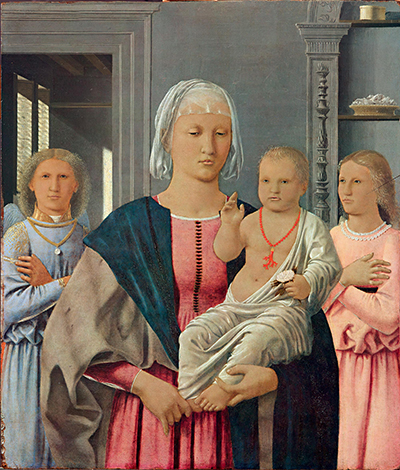At first, it's almost impossible to perceive that this is a Renaissance painting of the Virgin Mary. The only way to tell is by noticing the very recognizable Christ Child nestling in her arms. His right hand is raised as if in blessing.
And the two angels nearby. Otherwise, she could be any young Renaissance matron. Painted in 1474, as a small oil on panel painting, the Madonna di Sennigalia was intended for private devotion. It was eventually recognized as a Renaissance Madonna. and it has its place in the history of Renaissance paintings. It’s now kept in the National Gallery of the Marches in the former Ducal Palace in Urbino.
Piero della Francesco was a painter of the early Renaissance period. He was born and and lived in Sensepolcro in Tuscany, Italy, in the year of 1416. He died in 1492. He seems to have had a typical Renaissance personality. His interest wasn’t only in the area of art, but also in mathematics and geometry. Like many Renaissance achievers, he appears to have had an interest in diverse areas. But it is as a painter he is chiefly known. He painted the Madonna di Sennigalia around 1474. His most notable work is The Baptism of Christ, painted in or around 1450. It is now found in the National Gallery in London. Piero della Francesca seems to have worked mostly with oils and painted on panels.
On viewing the painting, we can see that the Madonna looks like a contemporary of the painter. Not a woman of Biblical times. There is a sense of lightness and airiness about this work. which shows the tremendous skill of the painter. To convey a sense of brightness and light through oils is a notable achievement indeed. It’s not for nothing that della Francesca is considered a master painter. His expertise in mathematics and geometry lends a mathematical precision in his artwork. His paintings were full of religious themes. He brought an almost contemporary feeling to Biblical tales through his artwork. Contemporary for Renaissance times, of course. Piero della Francesca, through his artistic achievements, brought glory to his native Tuscany. Tuscany, until today, continues to celebrate one of its greatest sons.




